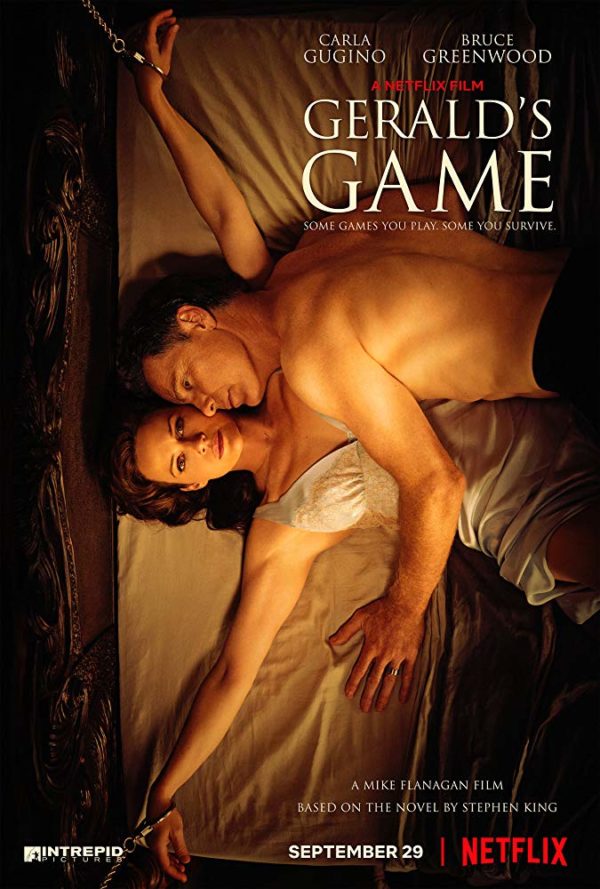
I grew up with a bunch of Stephen King. A lot of it in movies and mini-series as well as books.
Every now and then I’m reminded that I have, indeed, not seen all the stuff that’s been adapted to the screen.
In the case of Gerald’s Game, it’s also not a book of his I’ve gotten around to reading yet. So going into this, I knew next to nothing about anything outside of what shows up in the trailer of this Netflix produced film.
Just based on the strength of the cast and crew, though, I had a feeling it was going to be pretty solid. I was not disappointed. It’s very much a Stephen King story… and one that fits great with director/co-screenwriter Mike Flanagan‘s style.
The Plot
Gerald (Bruce Greenwood) and Jessie (Carla Gugino) are a married couple who’ve been having some issues, so they decide on a weekend getaway at a nice house out on a lake, far from their normal lives and responsibilities.
Trying to spice things up in their relationship a bit, Gerald handcuffs Jessie to the big bed. That doesn’t go well (because, really, there was no negotiation or other discussion about what is and isn’t cool when it came to being kinky… but we’ll talk about that later). While they’re arguing a bit, Jessie still handcuffed, Gerald goes and has a massive heart attack.
And then, things get very Stephen King.
The bulk of the film is Jessie talking to hallucinations of Gerald and herself as she tries to figure out how to survive and/or escape. That also draws her back into her childhood and the biggest and darkest secret that’s been gnawing at her since one day watching a solar eclipse with her father.
“Just uncuff me and we can talk.”
Even before things get weird in this film they get super uncomfortable and terrifying in a real-world kind of way.
It’s obvious from the writing and acting that Gerald and Jessie are having various issues in their marriage. Intimacy–both sexual and otherwise–is one of them. Even without hearing the story behind it (which we do get later), it’s clear that Gerald is the one who’s really into some kinky stuff.
That’s all good and fine, as Jessie is okay with it all at first. She agrees to be handcuffed and is willing to give it a try, especially if it will help things between them.
When Gerald pushes things a bit too far in role play–pretending to not be her husband and wanting her to scream for help and resist his advances–that’s when things get uncomfortable. When he doesn’t immediately listen to her and uncuff her when she demands it–and instead pushes more domineering power play, even in their discussion–that’s when you hit the first terrifying bit.
Jessie does everything she can to de-escalate the situation. She blames herself (he doesn’t take that, instead turning it around and accusing her of blaming him). She tries to flatter him (which he lashes back at, blaming her for all their problems). She begs, she pleads, she bargains, but he’s just not giving up his power/rape fantasy at all.
Well, not until he has a heart attack and slumps over dead.
That’s just in the first quarter of the movie and it’s more than enough to set off a whole lot of people who’ve been in situations like that. Dealing with a fragile yet overbearing man who won’t take no for an answer. It’s terrifying and it’s played very, very well by Gugino and Greenwood.
If that were the only consent trauma addressed, it would be more than enough for a solid reality base for the overall horror of the story.
Of course it’s not.
Because, as just about any woman will tell you, it’s never just one guy in their life who’s done something that’s made them uncomfortable and threatened (to say the least).
Through the rest of the film, with hallucinatory versions of herself and Gerald voicing her own fears and survival instincts, we see Jessie come to terms with her earlier trauma.
And we get a lot of references to other Stephen King properties. Including, but probably not limited to, Cujo, The Dark Tower series, Delores Claiborne, The Shining, and, depending on how you want to think about things, The Stand. Some of those reference come out of nowhere (there’s no justification given for Gerald’s “All things serve The Beam” reference, and the Cujo reference implies that books by Stephen King exist in the world of the film).
The Verdict
Due to the story’s solid basis in real-world traumas that far too many people (mostly women) have really suffered in one way or another, this film certainly isn’t for everyone. There’s only one gory bit–done so well that it even made me cringe–but even that’s nothing compared to the psychological trauma being dealt with.
It does all end on a mostly positive note, turning personal trauma into an impetus to help others and literally facing the monsters that were creeping around in the dark, so there is that.
I really liked it. Some of it is more of a slow burn (if your own personal traumas aren’t set off), but it all plays out at a decent pace. The performances–especially from Gugion when she’s doing double-duty as handcuffed Jessie and “survival instinct hallucination” Jessie. Greenwood hits that creepy balance between charm and “not quite right” that you know you’ve seen in the real world.
So, if you think you can handle the abuse themes, definitely give it a watch.

Leave a Reply